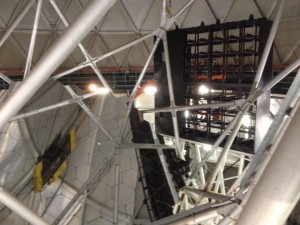This week has been fairly slow largely because we are cleaning up after last weeks VIRUS enclosure installation and because we have had many large rain storms.
In the Mirror Strip and Wash room we are making some modification to make it more user friendly and preparing for commissioning of the acid stripping process once the contractors have the acid vapor duct in place and the fan working. This should be ready to start sometime in the next two weeks.
Veliz Construction finished the Liquid Nitrogen slab backfill and sleeving for water line that must run under this slab. ARC also started the installation of the K-Hut exhaust fan. Weathers Electric continues running conduit between the pipe vault and the indoor breaker panel to support power lines to the dry cooler, Advantage Chiller and convenience outlet.
ARC Mechanical working with the Mitsubishi rep, tested out the HVAC system and it is now fully functional. This means we now have new air conditioning capability in the lower electrical room where all of the new tracker electronics are located as well as more powerful cooling capability in the spectrograph room. This will allow us to put the High Resolution Spectrograph in a cold bath which will help us keep a more constant temperature and improve velocity stability. Air conditioning has also been restored to the HET offices and the clean room.
Next week we will repeat of the 97-pt laster tracker test measuring only the hexapod control point, and a repeat of the 21-pt grid, measuring the control point as well as tip-tilt of the hexapod. This will provide an independent verification of the mount model imposed several weeks ago by the software and telescope controls group.

